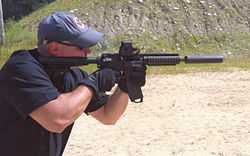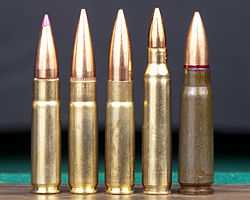300 AAC Blackout (7.62×35mm)
| 7.62×35mm / 300 AAC Blackout | ||||||||||||
|---|---|---|---|---|---|---|---|---|---|---|---|---|
|
The 300 AAC Blackout plastic tipped, left, compared to 300 AAC BLACKOUT 125 match, 300 AAC BLACKOUT 220 subsonic, 5.56x45mm NATO, and 7.62×39mm. | ||||||||||||
| Type | Rifle | |||||||||||
| Place of origin | United States | |||||||||||
| Specifications | ||||||||||||
| Parent case | 221 Fireball/.223 Rem | |||||||||||
| Case type | Rimless, Bottleneck | |||||||||||
| Bullet diameter | 0.308 in (7.8 mm) | |||||||||||
| Neck diameter | 0.334 in (8.5 mm) | |||||||||||
| Base diameter | 0.376 in (9.6 mm) | |||||||||||
| Rim diameter | 0.378 in (9.6 mm) | |||||||||||
| Case length | 1.368 in (34.7 mm) | |||||||||||
| Overall length | 2.26 in (57 mm) | |||||||||||
| Rifling twist | 1:7 | |||||||||||
| Primer type | Small rifle | |||||||||||
| Maximum pressure (SAAMI) | 55,000 psi (380 MPa) | |||||||||||
| Maximum pressure (CIP) | 62,366 psi (430.00 MPa) | |||||||||||
| Maximum CUP | 52000 CUP | |||||||||||
| Ballistic performance | ||||||||||||
| ||||||||||||
|
Test barrel length: 16 in Source(s): Official website | ||||||||||||
300 AAC Blackout, SAAMI short name 300 BLK, also known as 7.62×35mm is a rifle cartridge developed in the United States by Advanced Armament Corporation (AAC) for use in the M4 carbine. Its purpose is to achieve ballistics similar to the 7.62×39mm Soviet cartridge in an AR-15 platform while using standard AR-15 magazines at their normal capacity.
History
While 5.56×45mm NATO has enjoyed widespread acceptance in military circles, the nature of the missions encountered by some special operations groups often demand a round that not only provides better performance than that available in the high-energy standard velocity rounds, but one that can offer subsonic performance greater than the current standard 9mm Luger round.[1]
In an effort to satisfy this need the 300 AAC Blackout was created by Advanced Armament Corporation in cooperation with Remington Defense, under the direction of AAC's Research and Development Director Robert Silvers and with the support of the company's founder, Kevin Brittingham.[2][3]
The project's goals were:
- Create a reliable compact .30-cal solution for AR platform
- Use existing inventory magazines while retaining their full capacity
- Create the optimal platform for sound and flash suppressed fire
- Create compatible supersonic ammo that matches 7.62×39mm ballistics
- Provide the ability to penetrate barriers with high-mass projectiles
- Provide all capabilities in a shorter, lightweight, durable, and low recoiling package
Meeting these goals allowed the development team to negate many of the perceived drawbacks inherent to other large caliber cartridges when used in the M4 platform. Colt Firearms and other arms makers had previously chambered AR pattern rifles and carbines in various .30 caliber rounds but several issues were encountered. In the case of the 7.62×39mm, its relatively severe case angle caused feeding issues unless specially modified AK47 magazines were used, and even then results were less than outstanding.[4] Modified bolts were also needed owing to its larger case head diameter. Rounds such as the 6.8 SPC and 6.5 Grendel had similar part-interchangeability issues but did allow for the use of the standard M4/M16 30-round magazine albeit with a reduced capacity.[5]

Wildcat cartridges such as the .300 Whisper series addressed these issues but their widespread use in single shot handguns along with the lack of an industry standard cartridge dimension meant that a great number of the popular loads on both the supersonic and subsonic end of the spectrum were less than ideal in the AR pattern weapons. Many of these rounds required an excessively long overall cartridge length that would prohibit feeding in a STANAG magazine while using powder charges that were not compatible with the pressure requirements of the M4 carbine. This was particularly noticeable when using subsonic ammunition in conjunction with a suppressor as short stroking and excessive fouling would occur similar to that which was seen in the earliest variants of the M16 in Vietnam.[6]
By keeping the M4/M16 platform in mind as the primary host during load development the designers were able to work up a host of cartridges that would satisfy not only the ballistic requirements set forth but also ensure mechanical reliability with the fewest changes to the weapon itself, with only a simple barrel change being necessary for a complete conversion.[7]
300 AAC BLACKOUT was approved by SAAMI on January 17, 2011.
On October 23, 2011, SSG Daniel Horner of the USAMU used 300 AAC Blackout to win his 4th USPSA Multi-Gun National Championship.[8]
Performance

Maximum effective range = *460 metres (503 yd) 125 grain supersonic
- 200 metres (219 yd) 220 grain subsonic
| Barrel | Cartridge | Velocity | Energy |
|---|---|---|---|
| 9 in (230 mm) barrel | 300 AAC Blackout, 115 gr UMC | 2,120 ft/s (650 m/s) | 1,136 ft·lbf (1,540 J) |
| 16 in (410 mm) barrel | 300 AAC Blackout, 115 gr UMC | 2,295 ft/s (700 m/s) | 1,344 ft·lbf (1,822 J) |
| 9 in (230 mm) barrel | 300 AAC Blackout, 125 gr OTM | 2,030 ft/s (620 m/s) | 1,143 ft·lbf (1,550 J) |
| 16 in (410 mm) barrel | 300 AAC Blackout, 125 gr OTM | 2,215 ft/s (675 m/s) | 1,360 ft·lbf (1,840 J) |
The 300 AAC Blackout was designed to achieve energies similar to the 7.62×39mm Soviet in an AR-15 platform while using standard AR magazines at their full capacity. The 7.62 Soviet's cartridge taper prevented reliable feeding in AR magazines and created wear on the bolt. From the 14.5 in (370 mm) of the M4 Carbine, the M855 5.56 mm round has an effective point target range of 500 meters. The bullet has significant drop, drift, and energy loss at that distance. From a 16 in (410 mm) barrel, a 125 gr (8.1 g) 300 BLK round has a lower velocity and similar bullet drop and drift at shorter distances. However, it has the same amount of energy at 700 meters that the M855 has at 500 meters. In terms of hit probability, the Blackout has an effective range of 460 meters. From a 9 in (230 mm) barrel, the 125 gr BLK round has the same muzzle energy as the M855 from the M4, and 5 percent more energy at 440 meters. In comparison with 7.62×39mm rounds, 300 BLK rounds with varying loads have a better ballistic coefficient and more energy out of similar length barrels. 300 BLK rounds have "barrier blind" performance, being capable of penetration through several inches of different hard targets. The .30 caliber cartridge has an 89.1 percent increase in frontal bullet area over the 5.56 mm, and so leaves a large wound cavity in soft targets. It also penetrates deeper and initially yaws faster. 300 BLK rounds are effective out of barrels as short as 4.5 in (110 mm). Weapons chambered for the round can be as light, compact, and quiet when suppressed as submachine guns like the 9 mm Parabellum MP5 and 4.6×30mm MP7 while having more energy and accuracy at longer range.[9][10]
| Round | Weight | Barrel length | Muzzle velocity | Range for 100 in (2.5 m) of bullet drop | Range for 41 in (1.0 m) of bullet drift | Range for 291 ft·lbf (395 J) of energy | Effective range |
|---|---|---|---|---|---|---|---|
| M855 5.56 mm | 62 gr (4.0 g) | 14.5 in (370 mm) | 2,900 ft/s (880 m/s) | 500 m (550 yd) | 500 m (550 yd) | 500 m (550 yd) | 500 m (550 yd) |
| 300 BLK | 125 gr (8.1 g) | 16 in (410 mm) | 2,220 ft/s (680 m/s) | 440 m (480 yd) | 484 m (529 yd) | 700 m (770 yd) | 460 m (500 yd) |
| 300 BLK | 125 gr (8.1 g) | 9 in (230 mm) | 2,050 ft/s (620 m/s) | 410 m (450 yd) | 470 m (510 yd) | 625 m (684 yd) | 440 m (480 yd) |
| Round | Weight | Barrel length | Muzzle velocity | Ballistic coefficient | Energy at 300 meters |
|---|---|---|---|---|---|
| 7.62×39mm | 123 gr (8.0 g) | 16.5 in (420 mm) | 2,396 ft/s (730 m/s) | 0.280 | 712 J (525 ft·lbf) |
| 300 BLK | 115 gr (7.5 g) | 16 in (410 mm) | 2,295 ft/s (700 m/s) | 0.300 | 777 J (573 ft·lbf) |
| 300 BLK | 125 gr (8.1 g) | 16 in (410 mm) | 2,220 ft/s (680 m/s) | 0.320 | 829 J (611 ft·lbf) |
Compared to the 6.8×43mm Special Purpose Cartridge, another round made to have increased stopping power over the 5.56 NATO, the 300 Blackout has different capabilities. The 300 BLK was designed with a specific shorter-range focus to have equal or more energy than the 7.62 Soviet and work reliably with suppressors. The earlier 6.8 SPC was simply designed to have more energy at all ranges than the 5.56 mm. It has a relatively small projectile with a high velocity that maintains performance at range. At 200 yd (183 m), the 300 BLK drops 2 in (51 mm) lower than the 6.8 SPC, while it drops 30 in (760 mm) lower at 500 yd (457 m). The 115 gr (7.5 g) 6.8 round has a higher muzzle energy of 1,694 ft·lb (2,297 J) due to its greater velocity, while the 125 gr (8.1 g) 300 BLK round has a muzzle energy of 1,360 ft·lb (1,840 J). Both rounds were made to be used in an easily converted AR-15 platform. The 6.8 SPC has a more difficult conversion because it was designed around the .30 Remington cartridge, requiring a different bolt and decreasing standard magazine capacity. The 300 BLK was made specifically for ease of conversion, so the standard bolt will work and a magazine can be used to its full capacity, so the only change needed is the barrel.[11]
Extreme care should be taken with 300 BLK ammo, as with certain bullet profiles, the round may chamber in a standard .223 or 5.56 AR platform with disastrous results and possible injuries. [12]
Predecessors
- Pioneering work by the USAF Armament Lab at Eglin Air Force Base in the late 1960s produced the 7.62×28 cartridge which propelled a 172gr match projectile to the 1,050 ft/s (320 m/s) range but suffered from various reliability issues.[13]
- More recently, popular wildcats such the .300-221, .300 Fireball, and JD Jones' proprietary version of them, the .300 Whisper, have furthered the concept.[14]
The 300 AAC Blackout is a SAAMI standardized .300-221. Hornady states that any rifle chambered for the 300 AAC Blackout can shoot their .300 Whisper ammunition, which is made within 300 AAC Blackout specs. The reloading dies for these two cartridges are often the same.[15]
See also
- .300 Whisper
- 7.62x37mm Musang
- 7.62×40 Wilson Tactical
- List of rifle cartridges
- Table of handgun and rifle cartridges
References
- ↑ "Strategy Page".
- ↑ "Military Times".
- ↑ Guthrie, J (Jan 2013). "The 300 Blackout Story". Book of the AR-15.
- ↑ "Bigger Hammer".
- ↑ Lee, Jerry (12 August 2013). Gun Digest 2014. Iola, Wisconsin: Krause Publications. pp. 114–116. ISBN 978-1-4402-3542-9.
- ↑ "L. James Sullivan Interview". Small Arms Review. 2001.
- ↑ Cooke, Steve (Jan 2012). "The Ultimate Battle Round?". Recoil 1 (1).
- ↑ "Army Times".
- ↑ http://300aacblackout.com/resources/300-BLK.pdf
- ↑ http://www.dtic.mil/ndia/2012armaments/Wednesday13590Silvers.pdf
- ↑ "6.8 SPC versus 300 BLK?". Thetruthaboutguns.com. 24 September 2012.
- ↑ "300 Blackout in a .223 Wylde AR-15 Kaboom". http://bearingarms.com. 11 November 2013.
- ↑ Ordnance magazine Sept-Oct 1970
- ↑ Barnes, Frank C. (5 October 2012). Cartridges of the World: A Complete Illustrated Reference for More Than 1,500 Cartridges. Iola, Wisconsin: Gun Digest Books. pp. 436–437. ISBN 1-4402-3059-5.
- ↑ http://www.americanrifleman.org/articles/shades-of-gray/
External links
| Wikimedia Commons has media related to 300 AAC Blackout. |
| ||||||||||||||
